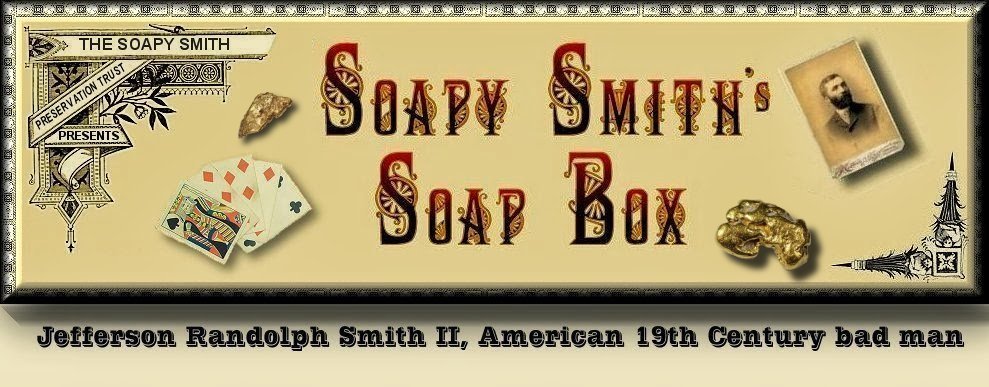S THAT SOAPY'S PARTNER IN CRIME?
Those who have read Alias Soapy Smith: The Life and Death of a Scoundrel, you may recall seeing the photograph (#6A) below, in the first photograph section of the book.
 |
| Soapy Smith and his partner in crime Harrison Ave. Leadville, Colorado July 21, 1880 Luke and Wheeler photographers Kyle Rosene collection |
(Click image to enlarge)
Soapy sent the above sterioview card to his sister. He wrote on the back
This is a crew of freighters we met in Leadville on the 21st of July 1880 in the morning on the day that Gen Grant arrived. You can see my photo by looking between the two wagons next to the man with the apron and his sleeves rolled up. (Soapy is between the two men, or in the rear, 3rd from the left) JRS. In other writing Soapy tells his sister Eva that the former president (1869-1877) is on horseback in the background. If you look closely you can see Grant on a very blurry horse.
It is Leadville, Colorado, July 21, 1880, the day ex-president U. S. Grant arrived in the city. There is a parade in his honor and a photographer(s) Luke and Wheeler set up a sterioview camera to take some photographic mementos of the day's celebration.
Notice the similarities to the photograph at the top of the post? This is because they were both taken by the same photographer, on the same day, close to the same location, one picture being taken before Grant passed by, and one taken afterwards. It is believed that the photo with Soapy was taken first, and the photographer quickly moved his equipment out of the street, for the passing of the parade, and then set up his equipment in the street once again, for another photograph, in which a large crowd took up their place in front of the camera. It is guessed that much of the crowd paid in advance for a copy of the sterioview.
 |
| Soapy Smith and his partner in crime Close-up Harrison Ave. Leadville, Colorado July 21, 1880 Luke and Wheeler photographers Kyle Rosene collection |
So, is Soapy possibly in both sterioviews? Below is a closeup of the latest Leadville sterioview card. It shows Harrison Avenue looking south. The Tabor Building, Clarendon Hotel building are seen on the left, and the Union Restaurant is across the street on the right.
(Click image to enlarge)
The close-up below appears to show Soapy's unnamed partner in crime, but I do not see Soapy himself. My guess is that now that Grant has passed by, Soapy is back to working the crowd for profit.
 |
| Close-up of crowd Soapy's Partner? Harrison Ave. Leadville, Colorado July 21, 1880 Luke and Wheeler photographers |

Soapy Smith in Leadville
Leadville, Colorado: pages 10, 36-37, 75, 77-78, 116, 123, 134-35, 144, 152, 176, 189, 192, 219, 225, 292, 297, 347, 349, 420, 509, 594.
"There are very few honest people up in that country," Said Bascomb last night. "I was told that my brother had $80 in cash in his clothes when he died, also that he owned several lots in Skaguay, a half-interest in Clancy’s saloon which was taking in probably $200 a day and an interest in the White Pass Trail.
The widow never got anything out of the estate. The money was gone and there was no trace of the lots, as they had never been recorded. Even a letter of thanks from the secretary of war could not be found and nearly everything in Jeff’s room had been stolen."
—Bascomb Smith













